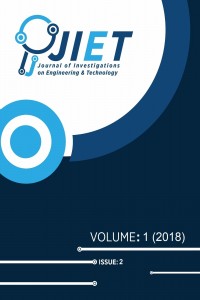Abstract
In
this study, a task-based programming learning environment with simple syntax
was developed. Existing environments are systems that are more difficult to
systematically develop, with more visual components being used, less
contribution to the programming transition process. Within the developed environment,
a new programming language has been defined, which is close to the actual
programming languages. The programming learning environment has been developed
as open source using computer science and engineering techniques, and is a
framework for researchers seeking to develop such an environment. The language
in the programming learning environment is verified by lexical and syntax
analysis steps. Finite state machines control the success of the task. Regular
expressions allow users to parse the code written by the user and make the
necessary analysis on the code.
Keywords
Programming Learning Environment Compiler Lexical Analysis Syntax Analysis Finite State Machines
References
- Özyurt, Ö., Özyurt, H., Aras, S. (2016, May). Çocukların Kodlama Öğrenebilecekleri Ortamların İncelenmesi. In International Computer and Instructional Technologies Symposium (ICITS) on (pp. 399-400).
- Resnick, M., Maloney, J., Monroy-Hernández, A., Rusk, N., Eastmond, E., Brennan, K., Kafai, Y. (2009). Scratch: programming for all. Communications of the ACM, 52(11), 60-67.
- Sengupta, P., Farris, A. V., Wright, M. (2012). From agents to continuous change via aesthetics: learning mechanics with visual agent-based computational modeling. Technology, Knowledge and Learning, 17(1-2), 23-42.
- Kölling, M. (2010). The greenfoot programming environment. ACM Transactions on Computing Education (TOCE), 10(4), 14.
- García, P. G., De la Rosa, F. (2016). RoBlock-Web App for Programming Learning. International Journal of Emerging Technologies in Learning, 11(12).
- Bers, M. U., Flannery, L., Kazakoff, E. R., Sullivan, A. (2014). Computational thinking and tinkering: Exploration of an early childhood robotics curriculum. Computers and Education, 72, 145-157.
- Papadakis, S., Kalogiannakis, M., Zaranis, N. (2016). Developing fundamental programming concepts and computational thinking with ScratchJr in preschool education: a case study. International Journal of Mobile Learning and Organisation, 10(3), 187-202.
- Fessakis, G., Gouli, E., Mavroudi, E. (2013). Problem solving by 5–6 years old kindergarten children in a computer programming environment: A case study. Computers and Education, 63, 87-97.
- Armoni, M., Meerbaum-Salant, O., Ben-Ari, M. (2015). From scratch to “real” programming. ACM Transactions on Computing Education (TOCE), 14(4), 25.
- Koorsse, M., Cilliers, C., Calitz, A. (2015). Programming assistance tools to support the learning of IT programming in South African secondary schools. Computers and Education, 82, 162-178.
- Aho, A. V., Sethi, R., Ullman, J. D. (2007). Compilers: principles, techniques, and tools (Vol. 2). Reading: Addison-wesley.
- Mogensen, T. Æ. (2009). Basics of Compiler Design. Torben Ægidius Mogensen.
- De Graaf, D. (2017). Practical use of Automata and Formal Languages in the compiler field.
Abstract
References
- Özyurt, Ö., Özyurt, H., Aras, S. (2016, May). Çocukların Kodlama Öğrenebilecekleri Ortamların İncelenmesi. In International Computer and Instructional Technologies Symposium (ICITS) on (pp. 399-400).
- Resnick, M., Maloney, J., Monroy-Hernández, A., Rusk, N., Eastmond, E., Brennan, K., Kafai, Y. (2009). Scratch: programming for all. Communications of the ACM, 52(11), 60-67.
- Sengupta, P., Farris, A. V., Wright, M. (2012). From agents to continuous change via aesthetics: learning mechanics with visual agent-based computational modeling. Technology, Knowledge and Learning, 17(1-2), 23-42.
- Kölling, M. (2010). The greenfoot programming environment. ACM Transactions on Computing Education (TOCE), 10(4), 14.
- García, P. G., De la Rosa, F. (2016). RoBlock-Web App for Programming Learning. International Journal of Emerging Technologies in Learning, 11(12).
- Bers, M. U., Flannery, L., Kazakoff, E. R., Sullivan, A. (2014). Computational thinking and tinkering: Exploration of an early childhood robotics curriculum. Computers and Education, 72, 145-157.
- Papadakis, S., Kalogiannakis, M., Zaranis, N. (2016). Developing fundamental programming concepts and computational thinking with ScratchJr in preschool education: a case study. International Journal of Mobile Learning and Organisation, 10(3), 187-202.
- Fessakis, G., Gouli, E., Mavroudi, E. (2013). Problem solving by 5–6 years old kindergarten children in a computer programming environment: A case study. Computers and Education, 63, 87-97.
- Armoni, M., Meerbaum-Salant, O., Ben-Ari, M. (2015). From scratch to “real” programming. ACM Transactions on Computing Education (TOCE), 14(4), 25.
- Koorsse, M., Cilliers, C., Calitz, A. (2015). Programming assistance tools to support the learning of IT programming in South African secondary schools. Computers and Education, 82, 162-178.
- Aho, A. V., Sethi, R., Ullman, J. D. (2007). Compilers: principles, techniques, and tools (Vol. 2). Reading: Addison-wesley.
- Mogensen, T. Æ. (2009). Basics of Compiler Design. Torben Ægidius Mogensen.
- De Graaf, D. (2017). Practical use of Automata and Formal Languages in the compiler field.
Details
| Primary Language | English |
|---|---|
| Journal Section | Research Papers |
| Authors | |
| Publication Date | December 30, 2018 |
| Submission Date | November 14, 2018 |
| Acceptance Date | December 31, 2018 |
| Published in Issue | Year 2018 Volume: 1 Issue: 2 |


